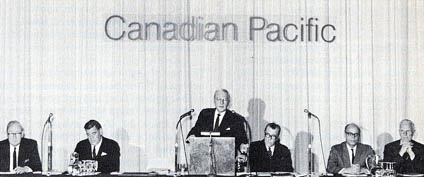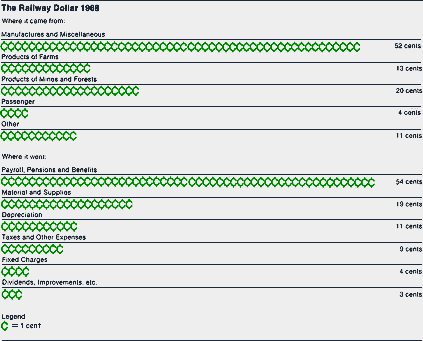 |
May/June 1969
Volume 8,
Number 3
|

Chairman N.R. Crump addresses shareholders at the annual meeting.
At his left are F.A. Rutherford vice-president and comptroller, and Ian D. Sinclair president. At
right are T.F. Turner secretary of the company, G.J. van den Berg vice-president finance, and S.M.
Gossage vice-president.
Canadian Pacific -
"reshaped so that it can provide expanded service and turn opportunity to advantage" - is setting its
sights on not merely sustaining its growth of recent years, but accelerating it.
Describing for shareholders at the 7 May 1969 annual general meeting the philosophy and objectives
of the "new" Canadian Pacific, Chairman N.R. Crump said that the dynamic new colours and symbol of the
transportation organization are important, not so much for themselves, but as a visual reflection of
"fundamental and far-reaching changes in our corporate life and style".
Changes which had their roots in the late 1950's and early 1960's have brought the company to the point today
where it is new "in a real and vital sense", he said. Latest in the succession of organizational
changes was the broadening of the "profit-centre" concept 1 May 1969 to CP Rail which
will now assume greater responsibility for its operation in the same manner as CP Ships, CP Express, CP
Transport, Smith Transport, CP Telecommunications, and CP Hotels.
"Whether the profit centre is a separate company as in the case of the CPI operating subsidiaries or a
department such as CP Telecommunications, the goal and method are the same. The goal is to improve earning by
stimulating the search for new areas of services and sales, increasing market share and improving efficiency.
The method is to create manageable-sized units, to give managers authority to manage and hold them
responsible for results", said Mr. Crump.
Issued prior to the annual meeting, the 1968 Annual Report said that one of the major objectives of CP Rail
will be to transform the challenge presented by the National Transportation Act into an opportunity for growth
in its operations through the creation of new techniques and concepts in the movement of goods by rail. The
report went on to refer to widening application of new pricing techniques such as multi-car and
train-load rates for liquefied petroleum gases and further development of unit train movements,
first applied to chemical traffic in 1967.
CP Rail will begin operation later this year of one of North America's most advanced unit trains, moving coal
from the B.C. interior to the Pacific coast under a contract signed last year with Kaiser Coal Ltd., for the
transportation over 15 years of 45.7 million long tons of coal destined for Japan. The contract led to the
placing of orders early this year for 348 specially-designed gondola cars and 21 locomotives, all
destined for unit train service.
Freight car purchases this year will total nearly 1,500 and another 500 are being acquired under
long-term\leasing arrangements, the annual meeting was told by President Ian D. Sinclair.
Included in the equipment purchases announced so far are additions to the fleets of
newsprint-service boxcars, mechanical refrigerators, and bulkhead-end flats, all in
demand in an increasingly specialized transportation market.
Also on order are container flatcars to handle land movement of traffic from CP Ships'
recently-inaugurated container service, new passenger cars for Montreal-area suburban
services, and more general-purpose locomotives.
Appropriations for 1969, approved up to 10 Mar 1969, amount to a total shown in the report of
$113.4 million, broken down into: $48.9 million for new locomotives, cars, and work equipment, $47
million for track improvements and other facilities, $4.9 million for buildings and structures, and $12.6
million for telecommunications, highway vehicles, and other properties.
The Annual Report listed 1968 income from CP Rail and miscellaneous sources other than Canadian Pacific
Investments Limited of $38.8 million after fixed charges, up $5 million over 1967.
Miscellaneous sources include earnings from CP Telecommunications and CP Ships and dividends from CP Express,
CP Transport, CP Air, and Canadian Pacific ( Bermuda ) Limited.
After payment of dividends of four percent on preference stock, the income per share of ordinary stock as $2.54,
compared with $2.19 in 1967. With the addition of $21.5 million in income from Canadian Pacific Investments
Limited, total earnings per ordinary share amounted to $4.04, compared with $3.59 in the previous year.
Dividends declared on the ordinary stock during 1968 totalled $3.00 per share, including $1.50 per share which
flowed through from Canadian Pacific Investments Limited. This compares with $2.90 in 1967 of which $1.40 was
attributable to Canadian Pacific Investments Limited.
The CPI annual report revealed:
Record income from oil, gas, and other mineral operations and the largest geophysical exploration program in
the company's history.
Sharply higher income from timber lands and related facilities due to increased residential construction,
favourable weather conditions, and an absence of work stoppages.
Improved earnings from industrial and commercial properties along with successful development of urban land
holdings across the country and the acquisition of additional properties.
Increases in investment income and the company's investment portfolio.
At 31 Dec 1968, 63.17 percent of the total voting rights in Canadian Pacific stock were held by
Canadians; 14.38 percent in the United Kingdom and other British countries; 15.75 percent in the United States
and 6.7 percent elsewhere.
 |
This CP Rail News article is copyright
1969 by the Canadian Pacific Railway and is reprinted here with
their permission. All photographs, logos, and trademarks are the property of the Canadian Pacific Railway
Company.
|